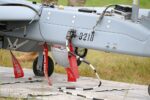The UK government is preparing new legislation that will grant the military broader powers to intercept and neutralize drones over domestic airspace under specific threat scenarios. The move reflects growing concern over the proliferation of commercial and improvised unmanned aerial systems (UAS), particularly in light of recent security incidents and evolving threat vectors.
New Legal Powers for Military Drone Interdiction
Currently, only police forces have the legal authority to use force against drones operating unlawfully in civilian airspace. Under proposed changes announced by the UK Home Office on 30 May 2024, the military would be empowered to detect, track, and—if necessary—disable or destroy drones deemed a threat to national security or public safety.
These powers are expected to be included in a forthcoming legislative package aimed at updating the UK’s counter-uncrewed aircraft systems (C-UAS) framework. The Ministry of Defence (MoD) will be authorized to act within domestic borders during high-risk events such as state visits, major sporting events, or when critical infrastructure is threatened.
Home Secretary James Cleverly stated that these updates are essential for “keeping people safe from evolving threats” and reflect “a modern approach” to drone regulation. The legislative update follows a policy review initiated after multiple drone incursions near sensitive sites and high-profile events.
Operational Scenarios Driving Policy Shift
The expanded authorities are designed for deployment during predefined scenarios where rapid response is essential:
- Major Public Events: Sporting events like Wimbledon or political summits where large crowds gather.
- VIP Protection: Royal ceremonies or visits by foreign dignitaries where airspace incursions could pose assassination or disruption risks.
- Critical Infrastructure Defense: Airports (e.g., Heathrow), nuclear facilities, and communication hubs vulnerable to surveillance or sabotage via drones.
The use of drones by criminal groups for smuggling contraband into prisons has also been cited as a growing concern. In 2023 alone, UK prison authorities recorded over 200 drone-related incidents involving attempts to deliver drugs or mobile phones into correctional facilities.
Evolving Counter-UAS Capabilities in the UK
The UK Armed Forces have been steadily investing in counter-UAS technologies through programs such as Project GUARDIAN and related trials with industry partners. These include kinetic options like net guns and directed-energy weapons as well as electronic warfare (EW) tools capable of jamming GNSS signals or taking control of rogue UAVs via protocol spoofing.
Key platforms under evaluation include:
- SkyWall Patrol: A man-portable net launcher developed by OpenWorks Engineering used by both police and military units for non-lethal drone capture.
- AUDS (Anti-UAV Defence System): A British-developed modular system combining radar detection with RF jamming and EO/IR tracking sensors. It has been deployed operationally overseas but could see expanded domestic use under new legal frameworks.
- D-Fend Solutions EnforceAir: A cyber-based takeover solution tested by several NATO countries that allows safe rerouting or landing of hostile drones without kinetic engagement.
The MoD has also participated in NATO’s C-UAS Capability Group initiatives aimed at standardizing interoperability across alliance members’ systems—a key consideration if foreign assets are deployed during joint homeland defense operations on UK soil.
Civil Liberties Concerns and Oversight Mechanisms
Civil liberties organizations have raised concerns about potential misuse of these expanded powers. Critics argue that giving military units authority over civilian airspace could lead to overreach unless clear rules of engagement (ROE), transparency mechanisms, and judicial oversight are established.
The Home Office has stated that any military intervention will require coordination with local law enforcement agencies and will be bound by strict operational guidelines. Use-of-force decisions must be proportional to the threat posed by the UAS target—particularly when operating near populated areas where debris from kinetic interception could cause collateral damage.
An independent oversight body may be proposed as part of the legislation package to audit deployments post-facto. Additionally, real-time coordination with Civil Aviation Authority (CAA) flight control systems will be mandated during active engagements near airports or controlled zones.
A Global Trend Toward Militarized Domestic C-UAS Response
The UK’s move mirrors similar trends across NATO allies who are grappling with increased drone activity in urban environments. For example:
- United States: The Department of Homeland Security (DHS) operates specialized C-UAS teams at major airports and border crossings; DoD assets can be deployed under Title 10 exceptions during national emergencies.
- France: Gendarmerie units were equipped with anti-drone rifles during Olympic Games preparations; French Armed Forces maintain deployable C-UAS elements for homeland protection missions under Vigipirate protocols.
- Germany: Bundeswehr supports federal police during high-risk events using EW-based drone neutralization kits integrated into its mobile SHORAD units like MANTIS systems adapted for urban defense roles.
This convergence between military-grade C-UAS capabilities and domestic security needs reflects a broader shift toward hybrid deterrence models—where traditional distinctions between internal policing and external defense continue to blur due to technological diffusion among non-state actors.
Ahead: Procurement Implications and Industry Opportunities
If passed into law later this year—as expected—the new authorities could drive fresh procurement rounds focused on rapidly deployable C-UAS kits optimized for urban environments. Key requirements likely include low-collateral effects, modularity for integration with existing MoD command-and-control networks (e.g., Bowman/CORTIS), and compliance with NATO STANAGs for coalition interoperability.
This opens opportunities for British defense SMEs specializing in sensor fusion algorithms, passive RF detection arrays, AI-enabled target classification engines, and directed energy platforms tailored for low-altitude aerial threats below radar horizon thresholds (~100 m AGL).
The Defence Science & Technology Laboratory (DSTL) is expected to play a central role in evaluating candidate solutions through live-fire trials at ranges such as MOD Shoeburyness or RAF Spadeadam later this year. Industry observers anticipate a potential £50–100 million funding envelope depending on final legislative scope—and whether permanent quick reaction forces (QRFs) are constituted within Joint Forces Command structures specifically tasked with homeland UAS interdiction missions.









